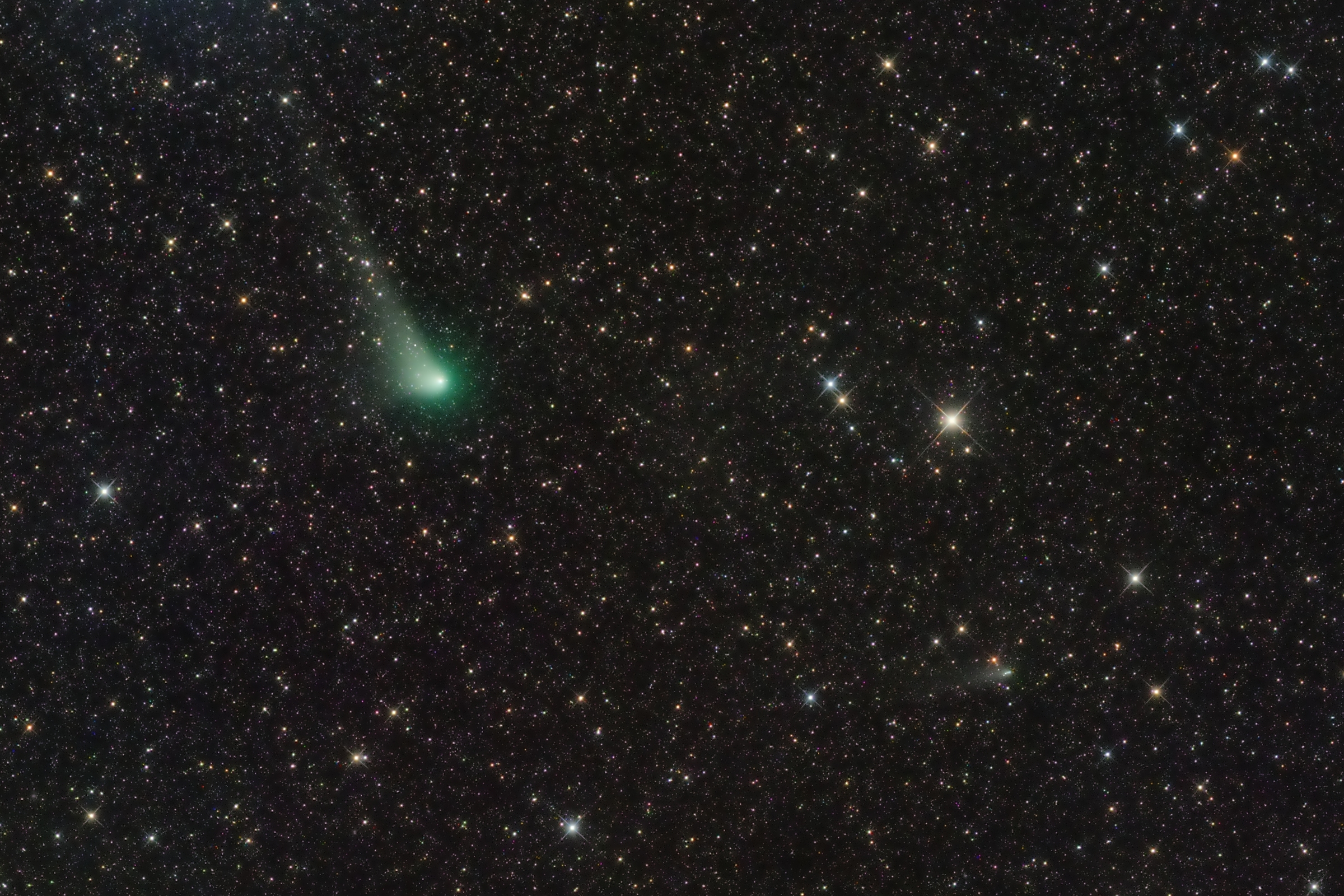Blog
This Picture of the Week showcases the impressive NGC 3627 galaxy, also known as Messier 66, located approximately 31 million light-years from Earth in the constellation Leo. The image was taken with the Multi-Unit Spectroscopic Explorer (MUSE) on ESO’s Very Large Telescope (VLT) in Chile. But why does it have these unusual colours? This image is a combination of observations conducted in different wavelengths of light. But rather than seeing the stars in this galaxy, as in more classical images, what this image displays is gas ionised by newly-born stars, with hydrogen, oxygen and sulphur shown in red, blue and orange respectively. The image was taken as part of the Physics at High Angular resolution in Nearby GalaxieS (PHANGS) project, which is using telescopes operating across all wavelengths to make high-resolution observations of nearby galaxies. The goal of the project is to better understand what triggers, boosts or holds back the formation of new stars in different environments.

October 10th 1948. Founder of the New Orleans white boy band the Radiators. The Radiators were formed in January 1978 after a jam session in keyboardist Ed Volker’s garage. At the time, Volker, Camile Baudoin and Frank Bua, Jr. were in a band called The Rhapsodizers, while Dave Malone and Reggie Scanlan were in a band called Road Apple. Scanlan had also, not long before, been a member of Professor Longhair’s touring band. The five musicians felt an immediate rapport. Scanlan later said, “we jammed for five hours straight, then all quit our old bands the next day. On April 6, 2019, Reggie Scanlan recalled how the band came to be “The Radiators.” After joining up and playing many shows together, without a formal band name, it was determined that a name was necessary. Scanlan suggested the name.
more...Cyril Garrett Neville (born October 10, 1948) is an American percussionist and vocalist who first came to prominence as a member of his brother Art Neville‘s funky New Orleans-based band, The Meters. He joined Art in the Neville Brothers band upon the dissolution of the Meters.
He has appeared on recordings by Bob Dylan, Robbie Robertson, Edie Brickell, Willie Nelson, Dr. John and The New Orleans Social Club among others.
Neville is interviewed on screen and appears in performance footage with The Neville Brothers in the 2005 documentary film Make It Funky!, which presents a history of New Orleans music and its influence on rhythm and blues, rock and roll, funk and jazz. In the film, the band performs “Fire on the Bayou” with guests Ivan and Ian Neville. Neville was also featured in the 2006 documentary film New Orleans Music in Exile.
In 2005, Neville joined up with Tab Benoit for the Voice of the Wetlands Allstars to bring awareness to Louisiana’s rapid loss of wetlands along the Gulf Coast. The band also features Waylon Thibodeaux, Johnny Sansone, Anders Osborne, Monk Boudreaux, George Porter, Jr., Johnny Vidacovich, and Dr. John. The band has become a main feature at the annual New Orleans Jazz & Heritage Festival.
After Hurricane Katrina he moved to Austin, Texas, but as of 2012 lives in Slidell, Louisiana.[citation needed] Soul Rebels Brass Band featured Neville as a special guest on their Rounder Records debut record, Unlock Your Mind, released on January 31, 2012. The Soul Rebels’ name was conceived by Neville at the New Orleans venue Tipitina’s, where the band was opening.
In 2010, Neville joined popular New Orleans funk band Galactic. He put aside his solo career to tour internationally with the band.
In 2012, Cyril Neville joined forces with Devon Allman (son of Gregg Allman of The Allman Brothers Band), award-winning blues-rock guitarist Mike Zito, bassist Charlie Wooton, and Grammy-winning drummer Yonrico Scott to form Royal Southern Brotherhood, a blues-rock supergroup.
more...John Edward Prine (October 10, 1946 – April 7, 2020) was an American singer-songwriter of country-folk music. He was active as a composer, recording artist, live performer, and occasional actor from the early 1970s until his death. He was known for an often humorous style of original music that has elements of protest and social commentary.
Born and raised in Maywood, Illinois, Prine learned to play the guitar at age 14. He attended classes at Chicago’s Old Town School of Folk Music. After serving in West Germany with the U.S. Army, he returned to Chicago in the late 1960s, where he worked as a mailman, writing and singing songs first as a hobby and then as a club performer.
A member of Chicago’s folk revival, Prine credited his fellow songwriter Steve Goodman with hounding singer-songwriter Kris Kristofferson to come listen to him, leading to his “discovering” him, resulting in Prine’s eponymous debut album with Atlantic Records in 1971. Film critic Roger Ebert was also among his early supporters. The acclaim Prine earned from his first LP led to three more albums for Atlantic. He then signed with Asylum Records, where he recorded three more albums. In 1981, he co-founded Oh Boy Records, an independent label where he released most of his subsequent albums.
Widely cited as one of the most influential songwriters of his generation, Prine was known for humorous lyrics about love, life, and current events, as well as serious songs with social commentary and songs that recollect sometimes melancholy tales from his life. According to Nobel laureate songwriter Bob Dylan, “Prine’s stuff is pure Proustian existentialism. Midwestern mindtrips to the nth degree. And he writes beautiful songs. . . . All that stuff about ‘Sam Stone‘, the soldier junkie daddy, and ‘Donald and Lydia’, where people make love from ten miles away. Nobody but Prine could write like that.” In 2020, Prine received the Grammy Lifetime Achievement Award.Prine was the son of William Mason Prine, a tool-and-die maker, and Verna Valentine (Hamm), a homemaker, both originally from Muhlenberg County, Kentucky. He was born and raised in the Chicago suburb of Maywood. In summers, they would go back to visit family near Paradise, Kentucky. Prine started playing guitar at age 14, taught by his brother, David. He attended classes at Chicago’s Old Town School of Folk Music, and graduated from Proviso East High School in Maywood, Illinois. He was a U.S. Postal Service mailman for five years and was drafted into the United States Army during the Vietnam War era, serving as a vehicle mechanic in West Germany before beginning his musical career in Chicago.
more...Julian Clifford Mance, Jr. (October 10, 1928 – January 17, 2021), known as Junior Mance, was an American jazz pianist and composer.
Mance was born in Evanston, Illinois. When he was five years old, Mance started playing piano on an upright in his family’s home in Evanston.[4] His father, Julian, taught Mance to play stride piano and boogie-woogie. With his father’s permission, Mance had his first professional gig in Chicago at the age of ten when his upstairs neighbor, a saxophone player, needed a replacement for a pianist who was ill. Mance was known to his family as “Junior” (to differentiate him from his father), and the nickname stuck with him throughout his professional career.
Mance’s mother encouraged him to study medicine at nearby Northwestern University in Evanston, but agreed to let him attend Roosevelt College in Chicago instead. Despite urging him to enroll in pre-med classes, Mance signed up for music classes, though he found that jazz was forbidden by the faculty, and did not finish out the year.
more...Thelonious Sphere Monk October 10, 1917 – February 17, 1982) was an American jazz pianist and composer. He had a unique improvisationalstyle and made numerous contributions to the standard jazz repertoire, including “‘Round Midnight“, “Blue Monk“, “Straight, No Chaser“, “Ruby, My Dear“, “In Walked Bud“, and “Well, You Needn’t“. Monk is the second-most-recorded jazz composer after Duke Ellington.[4]
Monk’s compositions and improvisations feature dissonances and angular melodic twists and are consistent with his unorthodox approach to the piano, which combined a highly percussive attack with abrupt, dramatic use of switched key releases, silences, and hesitations.
Monk’s distinct look included suits, hats, and sunglasses. He also had an idiosyncratic habit during performances: while other musicians continued playing, Monk would stop, stand up, and dance for a few moments before returning to the piano.
Monk is one of five jazz musicians to have been featured on the cover of Time (the others being Louis Armstrong, Dave Brubeck, Duke Ellington and Wynton Marsalis).
Thelonious Sphere Monk was born two years after his sister Marion on October 10, 1917, in Rocky Mount, North Carolina, and was the son of Thelonious and Barbara Monk. His poorly written birth certificate misspelled his first name as “Thelious” or “Thelius”. It also did not list his middle name, taken from his maternal grandfather, Sphere Batts. His brother, Thomas, was born in January 1920. In 1922, the family moved to the Phipps Houses, 243 West 63rd Street, in Manhattan, New York City; the neighborhood was known as San Juan Hill because of the many African-American veterans of the Spanish–American Warwho lived there (urban renewal displaced the long-time residents of the community, who saw their neighborhood replaced by the Amsterdam Housing Projects and Lincoln Center for the Performing Arts, though the Phipps Houses remained). Monk started playing the piano at the age of six, taking lessons from a neighbor, Alberta Simmons, who taught him stride playing in the style of Fats Waller, James P. Johnson and Eubie Blake. Monk’s mother also taught him to play some hymns, and he would sometimes accompany her singing at church. He attended Stuyvesant High School, a public school for gifted students, but did not graduate.
more...Harry “Sweets” Edison (October 10, 1915 – July 27, 1999) was an American jazz trumpeter and a member of the Count Basie Orchestra. His most important contribution was as a Hollywood studio musician, whose muted trumpet can be heard backing singers, most notably Frank Sinatra.
Edison was born in Columbus, Ohio, United States. He spent his early childhood in Louisville, Kentucky, being introduced to music by an uncle. After moving back to Columbus at the age of twelve, the young Edison began playing the trumpet with local bands.
In 1933, he became a member of the Jeter-Pillars Orchestra in Cleveland. Afterwards, he played with the Mills Blue Rhythm Band and Lucky Millinder. In 1937, he moved to New York and joined the Count Basie Orchestra. His colleagues included Buck Clayton, Lester Young (who named him “Sweets”), Buddy Tate, Freddie Green, Jo Jones, and other original members of that famous band.
more...Gusting solar winds and blasts of charged particles from the Sun resulted in several rewarding nights of auroras back in 2014 December, near the peak of the last 11-year solar cycle. The featured image captured dramatic auroras stretching across a sky near the town of Yellowknife in northernCanada. The auroras were so bright that they not only inspired awe, but were easily visible on an image exposure of only 1.3 seconds. A video takenconcurrently shows the dancing sky lights evolving in real time as tourists, many there just to see auroras, respond with cheers. The conical dwellings on the image right are tipis, while far in the background, near the image center, is the constellation of Orion. Auroras may increase again over the next few years as our Sunagain approaches solar maximum.
Kenny Garrett (born October 9, 1960 Detroit, MI) is an American post-bop jazzmusician and composer who gained recognition in his youth as a member of the Duke Ellington Orchestra and for his time with Miles Davis‘s band. His primary instruments are alto and soprano saxophone and flute. Since 1985, he has pursued a solo career.
more...John Winston Ono Lennon (born John Winston Lennon; 9 October 1940 – 8 December 1980) was an English singer, songwriter, musician and peace activist who achieved worldwide fame as the founder, co-songwriter, co-lead vocalist and rhythm guitarist of the Beatles. Lennon was characterised by the rebellious nature and acerbic wit in his music, writing and drawings, on film, and in interviews. His songwriting partnership with Paul McCartney remains the most successful in history.
more...Dionisio Ramón Emilio Valdés Amaro (October 9, 1918 – March 22, 2013), better known as Bebo Valdés, was a Cuban pianist, bandleader, composer and arranger. He was a central figure in the golden age of Cuban music, especially due to his big band arrangements and compositions of mambo, chachacháand batanga, a genre he created in 1952.
more...Abdullah Ibrahim (born Adolph Johannes Brand on 9 October 1934 and formerly known as Dollar Brand) is a South African pianist and composer. His music reflects many of the musical influences of his childhood in the multicultural port areas of Cape Town, ranging from traditional African songs to the gospel of the AME Church and Ragas, to more modern jazz and other Western styles. Ibrahim is considered the leading figure in the subgenre of Cape jazz. Within jazz, his music particularly reflects the influence of Thelonious Monk and Duke Ellington. He is known especially for “Mannenberg“, a jazz piece that became a notable anti-apartheid anthem.
During the apartheid era in the 1960s Ibrahim moved to New York City and, apart from a brief return to South Africa in the 1970s, remained in exile until the early ’90s. Over the decades he has toured the world extensively, appearing at major venues either as a solo artist or playing with other renowned musicians, including Max Roach, Carlos Ward and Randy Weston, as well as collaborating with classical orchestras in Europe. With his wife, the jazz singer Sathima Bea Benjamin, he is father to the New York underground rapper Jean Grae, as well as to a son, Tsakwe.
Ibrahim was born in Cape Town, South Africa, on 9 October 1934, and was baptized Adolph Johannes Brand. He attended Trafalgar High School in Cape Town’s District Six, and began piano lessons at the age of seven, making his professional debut at 15.[2] He is of mixed-race heritage, making him a Coloured person according to the apartheid system. His mother played piano in a church, the musical style of which would remain an influence; in addition, he learned to play several genres of music during his youth in Cape Town, including marabi, mbaqanga, and American jazz. He became well known in jazz circles in Cape Town and Johannesburg. In 1959 and 1960, Ibrahim played with the Jazz Epistles group in Sophiatown, alongside saxophonist Kippie Moeketsi, trumpeter Hugh Masekela, trombonist Jonas Gwangwa (who were all in the orchestra of the musical King Kong that opened in Johannesburg in February 1959).
more...Yusef Abdul Lateef (born William Emanuel Huddleston; October 9, 1920 – December 23, 2013) was an American jazz multi-instrumentalist, composer, and prominent figure among the Ahmadiyya Community in America.
Although Lateef’s main instruments were the tenor saxophone and flute, he also played oboe and bassoon, both rare in jazz, and non-western instruments such as the bamboo flute, shanai, shofar, xun, arghul and koto. He is known for having been an innovator in the blending of jazz with “Eastern” music. Peter Keepnews, in his New York Times obituary of Lateef, wrote that the musician “played world music before world music had a name”.
Lateef’s books included two novellas entitled A Night in the Garden of Love and Another Avenue, the short story collections Spheres and Rain Shapes, also his autobiography, The Gentle Giant, written in collaboration with Herb Boyd. Along with his record label YAL Records, Lateef owned Fana Music, a music publishing company. Lateef published his own work through Fana, which includes Yusef Lateef’s Flute Book of the Blues and many of his own orchestral compositions.
Lateef was born in Chattanooga, Tennessee as William Emanuel Huddleston. His family moved, in 1923, to Lorain, Ohio, and again in 1925, to Detroit, Michigan, where his father changed the family’s name to Evans.
more...Heading for its closest approach to the Sun or perihelion on December 20, comet C/2017 K2 (PanSTARRS) remains a sight for telescopic observers as it sweeps through planet Earth’s southern hemisphere skies. First time visitor from the remote Oort cloud this comet PanSTARRS sports a greenish coma and whitish dust tail about half a degree long at the upper left in a deep image from September 21. It also shares the starry field of view toward the constellation Scorpius with another comet, 73P/Schwassmann-Wachmann 3, seen about 1 degree below and right of PanSTARRS. Astronomers estimate that first time visitor comet C/2017 K2 (PanSTARRS) has been inbound from the Oort cloud for some 3 million years along a hyperbolic orbit. Schwassmann-Wachmann 3 is more familiar though. The periodic comet loops through its own elliptical orbit, from just beyond the orbit of Jupiter to the vicinity of Earth’s orbit, once every 5.4 years. Just passing in the night, this comet PanSTARRS is about 20 light-minutes from Earth in the September 21 image. Seen to be disintegrating since 1995, Schwassmann-Wachmann 3 was about 7.8 light-minutes away.

Al Duncan (October 8, 1927, McKinney, Texas — January 3, 1995, Las Vegas) was an American drummer and songwriter. Music critic and musicologist Eugene Chadbourne described Duncan as a “forefather of rhythm and blues” and “one of less than a half dozen key studio legends of the 1950s and 1960s who have sometimes been called the ‘grandfathers of groove’.” Chadbourne credited Duncan as helping develop the characteristic metric feel or timekeeping of rhythm and blues. His work is featured on recordings with Roy Buchanan, Billy “The Kid” Emerson, Buddy Guy, Dale Hawkins, Red Holloway, Camille Howard, Horace Palm, Jimmy Reed, Phil Upchurch, and Rob Wasserman among others.[2] Of the songs he penned, the best known is “It’s Too Late, Brother” which has become a blues staple.
more...More Posts
- Wilson Pickett
- Jose Mangual Sr
- Andy Narell
- Bill Frisell
- World Music Mohammed Reza Shadjarian & Ensemble Aref
- Daily Roots Ras Pidow
- Feed the Children
- St Patricks Day Music 2025
- Cosmo NGC 1499
- Paul Kantner
- Lovie Lee
- Alfred Newman
- Paul Horn
- Nat King Cole
- Daily Roots Paddyrasta
- Son Bonds
- Cosmo Venus Eclipse
- Minoru Miki
- Ramzan Paskayev
- Fred Neil
